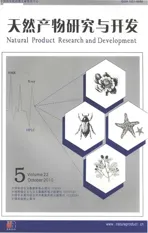十八种辛香料对五种食源性致病菌的抑菌研究
2010-10-09卢惠妮潘迎捷孙晓红
卢惠妮,潘迎捷,赵 勇,孙晓红
上海海洋大学食品学院,上海 201306
十八种辛香料对五种食源性致病菌的抑菌研究
卢惠妮,潘迎捷,赵 勇,孙晓红*
上海海洋大学食品学院,上海 201306
本实验研究 18种辛香料对五种食源性病原菌:单增李斯特菌,大肠杆菌 O157∶H7,肠炎沙门氏菌,副溶血性弧菌和金黄色葡萄球菌的抑制作用。辛香料以 60℃蒸馏水浸提。研究各种辛香料的最低抑菌浓度 (80~5 mg/mL)以及经 100℃处理 15 min和 121℃处理 15 min的稳定性。结果表明,大部分辛香料具有良好的抑菌效果,尤其是丁香和桂皮对副溶血弧菌和金黄色葡萄球菌的最低抑菌浓度为 5 mg/mL。经热处理部分香料失去了抑制作用,如八角,茴香,五香粉,海南白和黑胡椒,但大多数香料保持抑菌效果。这些结果表明,香料可抑制感染海产品的病原菌,同时在加工香料的过程中应该避免高温处理。
辛香料;食源性病原菌;抑菌活性;最低抑菌浓度;热处理
Abstract:The antimicrobial effects of eighteen spices were screened against five food-borne bacterial strains:L isteria m onocytogenes,Escherichia coliO157∶H7,Salm onella enteritidis,V ibrio parahaem olyticus,andStaphylococcus aureus.Spiceswere extracted by hotwater(60℃).Theminimum inhibitory concentrations(M ICs)of extractswere deter mined by the agar dilution method ranged from 80 to 5 mg/mL;The stability of extractswere measured by heat trea tment(100℃-15 min;121℃-15 min).The results showed that most spices have nice antibacterial activity,especially clove and cinnamon powder;The lowestM IC was 5 mg/mL observed in clove and Cassia twig powder act onV.parahaem olyticusandStaphylococcus aureus.By heat treatment,part of the spices apparently lost its inhibitory effect,such as star anise,fennel,spiced powder,Hainan white and black pepper,but themajority of spices keep their antibacterial effect.These results suggest that the spices can be practical for protecting seafood from the risk of contamination by food-borne pathogens and avoid high temperature trea tment during processing the spices.
Key words:spices;food-borne pathogen;antibacterial activity;M IC;heat treatment
Introduction
A very large number of bacteria such asL isteria m onocytogenes,Escherichia coliO157∶H7,Salm onella enteritidis,V ibrio parahaem olyticus,andStaphylococcus aureusare appear in various foods.Food-borne bacteria are also known to be responsible for their harmful to people’s health[1,2].
Listeria m onocytogenescan cause human meningitis,sepsis,abortion and other diseases.If the immune deficiencies infect itwill in a serious condition[3,4].E.coliO157∶H7 serotype belongs to EHEC,since 1982 itwas first discovered in the United States,including China and many other countries have reported.At present it has ranked second or third place.E.coliO 157∶H7 diarrhea caused by intestinal bleeding,about 2%to 7%ofpatientswill develop into hemolytic uremic syndrome[5].Infection ofSalm onella enteritidiswill appear abdominal cramps,flatulence,nausea,vomiting and other symptoms[6].Vibrio parahaem olyticususually reside in seafood such as cuttlefish,fish,shrimp,jellyfish,as well as containing high salt preserved foods such as pickles,bacon.Catch this bacterialwill presentabdominal pain,vomiting,diarrhea and other symptoms[7,8],Staphylococcus aureusis a kind of ubiquitous bacteria widely distributed in the water,air,dust,dirt dairy,flooring,the ground and come into contact with people of all things.It can cause localized suppurative infection;also can cause pneumonia,pseudomembranous enterocolitis,pericarditis,and even sepsis,systemic infection such as sepsis[9].
Since food poisoning because of infected by food-borne pathogens is still a threat for both consumers and food industry.Plant essential oil and essences can against several food-borne pathogens.At the same t ime,with the progress ofmaterial civilization and spiritual civilization,consumers pay more attention on the food safety.So it is necessary to study and research the development of antibacterial activity of natural substances,for inhibiting the growth of microorganis ms to ensure food safety[10].
Antimicrobial substances from naturalsources like plants and spices have been investigated to inhibit the growth of bacterial.The oils of bay,cinnamon,clove and thyme exhibit ant imicrobial properties,and Grampositive bacteria are more sensitive to inhibition by plant essential oils than the Gram-negative bacteria[11].Natural products from medicinal plants have the antibacterial activities.For example,Ethanol extracts from Australian traditionalmedicinal plantsErem ophila alternifoliaandErem ophila duttonii,have been found to inhibit the growth ofL.m onocytogenes[12].
The objective of the present study was to est imate the antibacterial activity of common eighteen edible spices against five common food-borne pathogens.The M IC,the physical stability of each spice extracts.Aim to acquire the especial spicewhich has the best antibacterial effect.Develop it into natural preservative which substitute synthesis chemical preservative in the use of food industry to guarantee people’s health.The further research is to study the antibacterialmechanism andwork out its components.
Materials andM ethods
Spice samples preparation
Eighteen edible spices used in this study were Chili powder,Clove powder,Dehydrated ginger powder,Turmeric powder,Licorice powder,Star anise powder,Onion powder,cassia twig powder,Dehydrated chive powder,Pepper,Hainan white pepper,Hainan black pepper,Fennel powder,Cumin powder,Garlic powder,Cinnamon powder,Chenpi powder,and Spiced powder.These spices were chosen based on their reported biological activities.All spices were purchased from X INGHUASH I HURONG FOODS CO.,LTD.The peel or rhizome parts of spices were air-dried and then grind them into powder(Over 80 mesh sieve)and stored in vacuum-packed bags at room temperature.
Extraction of spice material
Take 8 g of every spice powder material,and then add 100mL distilledwater,extract them in 60℃for5 h,after extraction,centrifugation them (4000 r/min,15 min),collect the supernatant,placed in the refrigerator 4℃for preservation.The extract concentration of each spice is 80 mg/mL.
Testm icroorgan is m s
Five bacterial strains used in this study,including Escherichia coli ATCC 43889,V ibrio parahaem olyticusATCC 33846,Sa lm onella enteritidisCMCC 50041,L isteria m onocytogenesATCC 7644 purchased in the Chinese Academy of Sciences Institute of Microbiology;StaphylococcusaureusAB 91093 is preserved by Shanghai Municipal Center for Disease Control and Prevention.Bacterial strains were incubated at 37℃(exceptL.m onocytogeneswas cultivated at 30℃)and maintained on a nutrient agar slant at 4℃.
Ant im icrobial activity assay
Ant imicrobial activity assaywas determined inhibit five food-borne pathogenic bacterial by the agar plate drilling method.Bacterial strainswere maintained on nutrient agar at 37℃(exceptL.m onocytogenensat 30℃)and overnight cultureswere prepared in nutrient broth.The cultures were diluted with sterilized saline to get the number of approximately 105CFU/mL.Spread 100 μL bacteria liquid on each agar dish.And then drill four holes in one agar plate(6 mm in diameter/every hole),each hole inject 30μL spice extracts[13-15].The plates cultivated at 37℃(exceptL.m onocytogeneswas cultivated at 30℃)for 24 h,measure the inhibitionzone to bring out the antibacterial activity.Three replicates were prepared for each extract in this study.Meantime use sterile water as a negative control.
M in imum inhibitory concentration(M IC)of spice Extracts
M IC of these sampleswere deter mined by the nutritional broth dilution method using the serially diluted spice extracts,and we can acquire series concentration spices solution:40,20,10,5,2.5 mg/mL.Bacterial cultures were prepared in nutritional broth and incubated at 37℃(exceptL.monocytogenes was incubated at 30℃)for 8 h.Then adjust the concentration of these bacterial cultures to 105CFU/mL[16,17].
After ward add 10μL each bacterial to each concentration spice solution,the mixture was then incubated at 37℃for 24 h(exceptL.m onocytogenesat 30℃).After incubation,using flat line method crosses the liquid culture of bacteria to the plate,cultivated at 37℃for 24 h (exceptL.m onocytogenesat 30℃).Observe whether there is any bacteria grow,there is no bacteria in the growth plate of the lowest concentration of extract is the minimum inhibitory concentrationM IC.
Three replicateswere prepared for each extract in this study.Meantime use sterile water as a negative control,use series concentration potassium sorbate(2.5,5,10,
20 40 g/kg)as positive control.
Stability testing
Heat stability testing
Through heat trea tmentmethod measure the stability of the eighteen spice extracts,In this study use 100℃and 121℃to dealwith the eighteen spices(the concentration is lower than a concentration gradient of each M IC)about 10 min.Then we used them to study these inhibitory of five pathogens(Method is as same as the M IC determination)to observe the trial of the growth of bacteria and to compare the ther mal stability of their antibacterial[18,19].Three replicates were prepared for each extract in this study.Meantime use sterilewater as a negative control.
Tim e stability testing
Choose the sample that had the best antibacterial activity,and then use it to test the antibacterial activity time.The culture method is as same as the for mer.
Results
I nhibitory effect of spices extracts on the bacterial food-borne pathogens
The results of screening the antimicrobial activity of the extracts are given in Table 1.The extract solvent is distilled water.
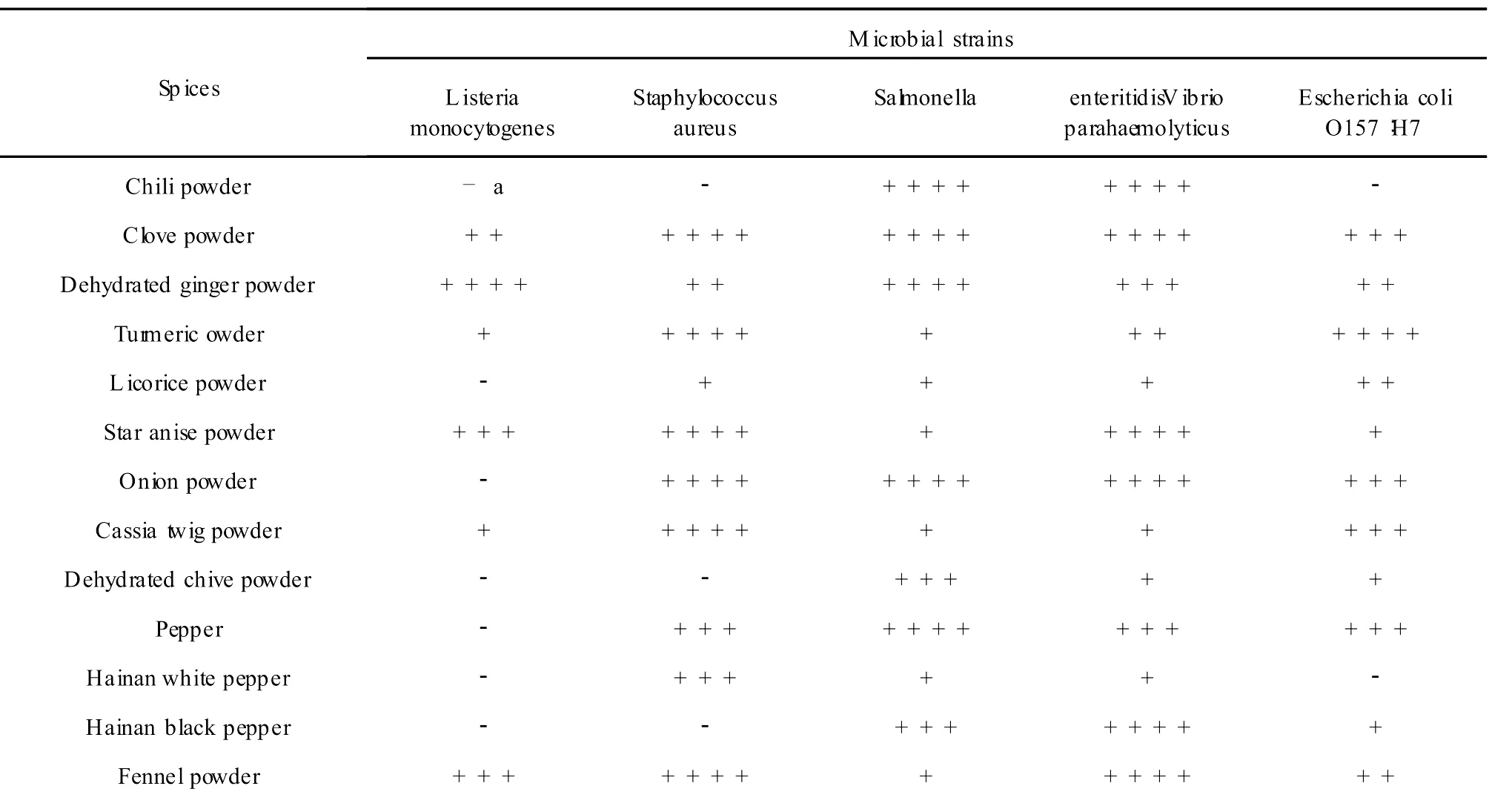
Table 1 Ant im icrob ial effect of eighteen spice extracts on the growth of food-borne pathogens

Note:-a,on behalfof inhibition zone diameterof6-7 mm;+,on behalfof inhibition zone diameterof7.1-8 mm;++,on behalfof inhibition zone diameter of 8.1-9 mm;+++,on behalf of inhibition zone diameter of 9.1-10 mm;++++,on behalf of inhibition zone diameter ofmore than 10.1 mm.
The water extract of clove powder exhibited good bacteriostatic activity against two Gram-positive bacteria(Staphylococcus aureusandL isteria m onocytogenes),three Gram-negative bacterium(Escherichia coliO157∶H7,V ibrio parahaem olyticusandSalm onella enteritidis),so as ginger,Turmeric,Star anise,Cassia twig,Fennel and Cinnamon powder(Table 1).But others display partial antibacterial;maybe its effect componentswere lost in the process.
Clover powder extract and chili powder extract showed good inhibition ofV ibrio parahaem olyticuson nutrient agar plate,but Cassia twig powder exhibited weak antibacterial effect ofV.parahaem olyticus,and as negative,sterile water displayed no effect onV.parahaem olyticus(Fig.1).
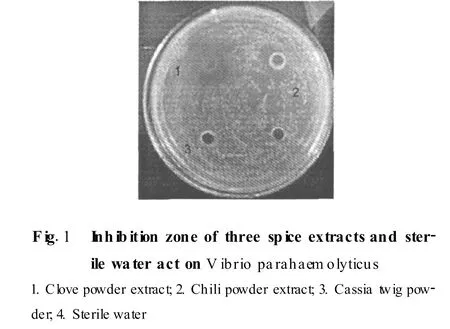
The water extract of spiced powder,cassia twig,turmeric powder and onion powder all showed apparent inhibition zone(Fig.2).
Clove powder extract and dehydrated ginger powder displayed good antibacterial activity onSalm onella enteritidi,but the extract of cinnamon powder and spiced powder had weak inhibitory on this food-borne pathogen(Fig.3).
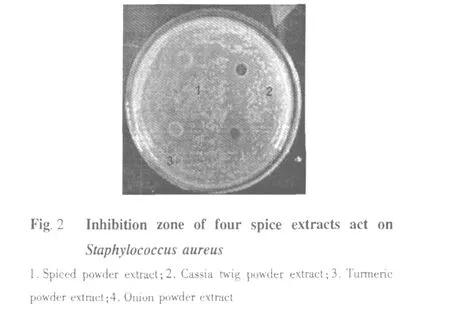

M I Cs of spice extracts
From the data(Table 2),the mass of spices showed the lowerminimum inhibitory concentrations;especially clove powder extract had theM IC of 5 mg/mL onV ibrio parahaem olyticus,cassia twig powder extract had the M IC of 5 mg/mL onStaphylococcus aureus).Tur meric powder,Licorice powder,Star anise powder,Pepper powder,Cinnamon powder and Spiced powder also display good antibacterial effect.But Hainan white pepper and fennel powder inhibitE.coliO157∶H7 represent higherM IC.

Table 2 Minimum inhibitory concentrations(mg/mL)of spices and herbs aga inst five bacter ial
This exper iment using a common food preservative potassium sorbate as a positive control,results showed that theM IC of potassium sorbate is higher than some spicesM I C,especially clove powder extract.Itmay because that the pH is not suitable for potassium sorbate to play its inhibitory effect on the medium.
The result of stability test ing
The result of heat stability testing
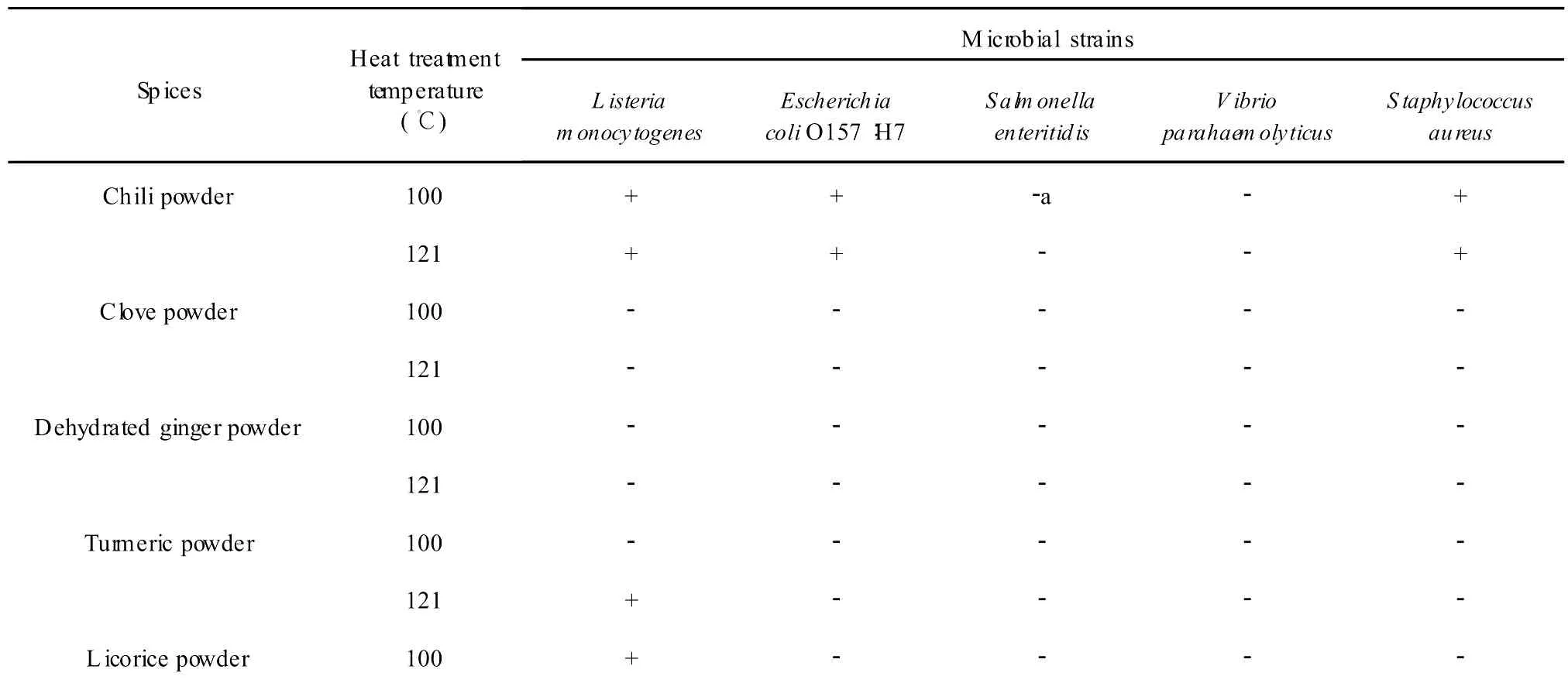
Table 3 Heat stability of eighteen spice extracts

Note:-a,stands for non-bacteria growth;+,stands for little bacteria growth;++,stands for more bacteria growth;+++,stands for the most bacteria growth;CK1:negative control(Sterile water).
Data are summarized in Table 3,Most of Spices processed by 100℃after 15 min have no weakening its antibacterial activity,except star anise powder,fennel powder and spiced powder have waken its inhibitory effect onL.m onocytogene.Onion powder and cinnamon powder lost its antibacterial activity onSalm onella enteritidis,pepper powder,dehydrated chive powder,Hainan white pepper and Hainan black pepper also miss its inhibitory effect on some bacteria.Tur meric powder,onion powder,cinnamon powder,Hainan white
pepper and Hainan black pepper by way of 121℃after 15 min lost its bacteriostatic effect on part of five food-borne pathogen.Clove powder show the strong stability of antibacterial effect on five bacterial either heat on 100℃,15 min or 121℃,5 min.
Tim e stability testing
From the above figures,it is obvious that clove powder extract had the best inhibitory effect,so this study further research the t ime stability of clove extract on five food-borne bacteria.

Table 4 T ime stability of clove powder extract
From Table 4,it is apparent that the antibacterial time of clove powder extracton five pathogenswas about 3 d under the culture temperature of 30℃/37℃.
D iscussionAll spice extract exhibit good bacteriostatic effect on five food-borne pathogens,most spice extracts displayed the heat stability,just partial of them lost its antibacterial effect.Clove powder distilled water extract show the best antibacterial effect on five food-borne pathogens.It also had the lowerM I C,after heat treatment process it keeps good inhibitory effect all the same.
Gram-negative bacteria were shown to be generally more resistant than gram-positive ones to the antibacterial activity of spice extracts because of their wall lippolysaccharide[20].But this study showedStaphylococcus aureuscould be easily inhibited by spice extracts.Overall,the data suggested that the spices can be practical for protecting seafood from the risk of contamination by food-borne pathogens and avoid high temperature treatment during processing the spices.AcknowledgementsWe are grateful to X INGHUASH IHURONG FOODS CO.,LTD for providing the eighteen spices.We also thank Professor PANG Yingjie,Associate Professor ZHAO Yong,and teacher SUN Xiao-hong at ShanghaiOcean University for their valuable help with the microbiologicalwork and field assistance.
1 Mead PS,SlutskerL,Dietz V,et al.Food related illness anddeath in the United States.Em erg Infect,1999,5:607-625.2 SanlierN.The knowledge and practice of food safety by young and adult consumers.Food Control,2009,20:538-542.
3 Al lmannM,et al.Polymerase chain reaction(PCR)for detection of pathogenic microorganisms in bacteriologicalmonitoring of dairy products.ResM icrobial,1995,146:85-97.
4 Vrinda Menon K,Garg SR.Inhibitory effect of clove oil on Listeria monocytogenes in meat and cheese.Food M icrobiology,2001,18:647-650.
5 AbdullahD,et al.HassanBacterial quality of raw milk investigated byEscherichia coliand isolates analysis for specific virulence-gene markers.Food Control,2009,20:913-917.
6 Thorns CJ.Salm onella fim briae:novel antigens in the detection and control of salmonella infections.B r vet J,1995,151:643-658.
7 Etinosa O.Igbinosa,Anthony I.Okoh.Emerging Vibrio species:an unending threat to public health in developing countries.Research in M icrobiology,2008,159:495-506.
8 Su YC,Liu CC.Vibrio parahaemolyticus:A concern of seafood safety.Food M icrobiology,2007,24:549-558.
9 Kouabenan DR,et al.Methicillin-resistant Staphylococcus aureus risk perception by healthcare personnel in a public hospital.Social Behavior and Personality,2007,35:89-100.
10 Saĝdic O,Özcan M.Antibacterial activity of Turkish spice hydrosols.Food Control,2003,14:141-143.
11 Smith-Pa lmerA,et al.Ant imicrobialpropertiesof plant essential oils and essences against?ve important food-borne pathogens.Letters in AppliedM icrobiology,1998,26:118-122.
12 Owen RJ,Palombo EA.Anti-listerial activity of ethanolic extracts of medicinal plants,Eremophila alternifolia and Eremophila duttonii,in food homogenates and milk.Food Control,2007,18:387-390.
13 Mu L,Liao HW,Yin Y,et al.A new method for screen common Chinese herb medicine as bacterial inhibitor.China Food Additives,2008,(6):112-117.
14 Wang SQ.Determination of antibiotics in perforated titer.B iological bulletin,2004,40:2.
15 LiD,Zhou LG,Wang JG,et al.Inhibitory effects of Sophora alopecuroides extract to pathogens on cucumber and tomato.Acta Bot Boreal-Occident Sin,2006,26:558-563.
16 Wu ZH,Xu Y,Wu CM.Study on the method of extracting natural preservative in aniseed and its bacteriostasis.China condim ent,2003,9:18-20.
17 Wu ZH,et al.Pepper in the extraction of natural preservatives and antimicrobial effect.Food Industry,2004,5:18-19.
18 Tan JJ.The research of bacteriostasis characteristic onD ictyophora.Food Sci,2001,22(9):73-75.
19 Han H,Zhang G.Studies on antibacterial role ofD ictyophora gown.Food Res Dev,2008,29(5):129-131.
20 RussellAD.Mechanismsof bacterial resistance to non-antibiotics:food additives and food and pharmaceutical preservatives.Journal of Applied Bacteriology,1991,71:191-201.
Antibacterial Activity of Eighteen Edible Spice Extracts on Five Food-borne Bacteria
LU Hui-ni,PAN Ying-jie,ZHAO Yong,SUN Xiao-hong*
College of Food Science and Technology,Shanghai Ocean University,Shanghai 201306,China
Q946.91;R285;TS202.3
A
1001-6880(2010)05-0883-08
ReceivedMay 13,2009;Accepted 2009-07-03
*Corresponding author Tel:86-21-61900379;E-mail:yjpan@shou.edu.cn
